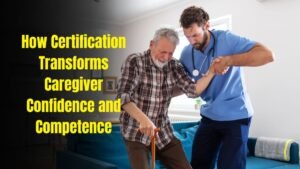In the evolving world of caregiving, emotional intelligence and psychological endurance have become as essential as technical skill. The ability to bounce back from emotional challenges, adapt to stress, and maintain compassion under pressure is what defines emotional resilience.
Teaching emotional resilience in caregiver training ensures that professionals can sustain their work without burning out, while also providing empathetic, consistent care to patients.
According to recent global health data, over 40% of caregivers experience high levels of stress, and nearly one-third show signs of clinical burnout.
Emotional resilience training programs are proving to be a practical solution—helping caregivers process grief, regulate emotions, and maintain balance in demanding healthcare environments.
What Is Emotional Resilience in Caregiving?
Emotional resilience is the capacity to adapt positively in the face of stress, adversity, or trauma. In caregiving, this resilience manifests through the ability to manage difficult situations—patient loss, chronic stress, or emotional exhaustion—while maintaining professionalism and empathy.
Building resilience doesn’t mean suppressing emotions; rather, it involves understanding emotions, developing coping mechanisms, and nurturing mental flexibility to handle crises calmly.
Key aspects include:
- Emotional regulation – balancing empathy with professional detachment.
- Self-awareness – recognizing personal stress signals.
- Optimism and adaptability – focusing on problem-solving rather than fear or guilt.
- Social connection – leaning on peers and mentors for shared understanding.
Why Emotional Resilience Training Is Essential
| Challenge | Without Resilience Training | With Resilience Training |
|---|---|---|
| Compassion fatigue | Leads to emotional numbness, reduced empathy | Better emotional control and sustained compassion |
| Long working hours | Burnout and physical exhaustion | Improved coping mechanisms and self-care habits |
| Patient loss or decline | Depression, guilt, grief overload | Healthy emotional processing and recovery |
| Isolation | Social withdrawal and stress buildup | Stronger peer connections and communication |
| Role ambiguity | Loss of purpose and motivation | Clear boundaries and renewed sense of purpose |
Resilient caregivers deliver better patient outcomes, maintain higher morale, and contribute to lower turnover rates in healthcare institutions. This makes emotional resilience not only a personal asset but also a critical organizational performance factor.
Key Components of Emotional Resilience Training
- Mindfulness and Emotional Awareness
Caregivers learn to stay present and grounded during stressful moments through meditation, journaling, or reflection techniques. Mindfulness reduces cortisol levels and promotes emotional clarity. - Cognitive Behavioral Techniques (CBT)
CBT strategies help caregivers reframe negative thoughts, transforming stress into manageable challenges rather than overwhelming problems. - Empathy and Boundaries
Training modules emphasize how to maintain empathy while establishing emotional limits. This helps prevent compassion fatigue and over-identification with patients. - Peer Support and Group Reflection
Shared experiences foster understanding and connection. Peer groups provide safe spaces for caregivers to discuss emotional difficulties without judgment. - Stress-Management and Self-Care Planning
Structured self-care strategies—sleep hygiene, physical exercise, nutrition, and scheduled breaks—help caregivers maintain long-term health. - Communication and Conflict Resolution Skills
Emotional resilience also relies on clear communication and the ability to resolve conflicts in patient-care settings or within teams.
Structure of a Resilience Training Program
| Training Element | Description |
|---|---|
| Duration | Typically 4–8 weeks, combining weekly workshops and self-reflection sessions |
| Format | Hybrid model – interactive classroom instruction and digital follow-up |
| Key Topics | Stress management, empathy balance, self-care, communication, cognitive reframing |
| Assessment Tools | Emotional Resilience Scale (ERS), Caregiver Strain Index, self-reflective journals |
| Outcomes | Improved emotional regulation, reduced burnout, enhanced care quality |
Programs often begin with a baseline stress and resilience assessment, followed by ongoing support groups and follow-up workshops to reinforce learned strategies.
Evidence-Based Benefits of Teaching Emotional Resilience
Studies consistently show that resilience education leads to measurable improvements in caregiver well-being and patient care quality. Some notable outcomes include:
- 30–40% reduction in stress-related absenteeism among trained caregivers.
- 25% improvement in emotional stability and confidence levels after six weeks of structured mindfulness and reflection training.
- Higher job satisfaction scores and reduced intent to quit within the first year of employment.
Emotional resilience also correlates with improved patient satisfaction, as caregivers with balanced emotions are better communicators and more empathetic listeners.
Integrating Emotional Resilience into Caregiver Curriculums
To embed resilience into caregiver education, training institutions and healthcare organizations should:
- Introduce emotional intelligence modules early in certification programs.
- Include scenario-based learning, simulating stressful caregiving situations.
- Establish ongoing mentorship and peer support groups.
- Create well-being policies promoting rest breaks, counseling access, and stress monitoring.
Healthcare organizations that incorporate emotional resilience as a core competency report higher retention rates and a more positive work culture.
Best Practices for Trainers
- Encourage open discussion about emotions rather than suppressing them.
- Use storytelling or case studies to normalize stress reactions.
- Reinforce self-compassion exercises—affirmations, gratitude lists, or visualization.
- Track progress through feedback surveys and resilience metrics.
- Offer follow-up booster sessions after the training concludes.
Training should always be interactive and reflective, focusing on both personal and professional development.
Measuring Success in Emotional Resilience Programs
| Evaluation Metric | Purpose | Measurement Method |
|---|---|---|
| Resilience Level | Assess personal growth | Pre- and post-training self-assessment |
| Caregiver Stress Index | Evaluate burnout risk | Standardized questionnaire |
| Job Satisfaction | Measure morale improvement | Surveys and interviews |
| Absenteeism/Retention | Track organizational impact | HR data tracking |
| Peer Feedback | Monitor communication and empathy | Team-based feedback cycles |
Effective programs combine quantitative results with qualitative insights, ensuring that emotional resilience isn’t just measured but continuously nurtured.
Real-Life Application: A Case Example
A long-term care facility implemented a 6-week emotional resilience program for 60 nursing assistants. Participants reported:
- 35% lower burnout levels by week six.
- 20% increase in self-reported empathy scores.
- Improved teamwork and communication within patient care units.
This case demonstrates that even short-term training can lead to substantial improvements in emotional well-being and care delivery.
Challenges in Implementing Resilience Training
Despite its proven benefits, emotional resilience training faces barriers such as:
- Limited funding or time allocation in care facilities.
- Cultural stigma surrounding emotional expression in professional environments.
- Lack of qualified trainers specializing in emotional resilience education.
To overcome these obstacles, leaders must prioritize emotional wellness as a policy goal rather than a personal responsibility.
Teaching emotional resilience in caregiver training is not just an educational exercise—it’s a commitment to sustaining human compassion in healthcare.
Caregivers who cultivate emotional resilience become stronger, more empathetic, and more capable of delivering consistent, quality care.
When institutions make resilience education a central pillar of caregiver development, they invest in healthier staff, happier patients, and a more humane healthcare system.
Emotional resilience transforms caregiving from a draining duty into a fulfilling act of strength and empathy—proving that the most powerful care begins with emotional balance.
FAQs
Can emotional resilience be developed later in life or only during training?
Yes. Emotional resilience is a skill that can be strengthened at any stage through consistent practice, mindfulness, and reflection.
How can organizations encourage caregivers to embrace resilience training?
Organizations can promote resilience by integrating it into ongoing professional development, offering incentives, and creating a culture that values emotional well-being.
What are quick techniques caregivers can use daily to build resilience?
Deep breathing, mindfulness breaks, journaling, and brief moments of gratitude can reduce stress and boost mental clarity.




